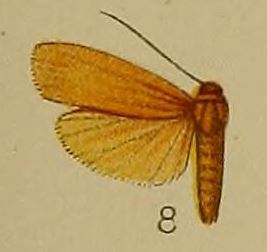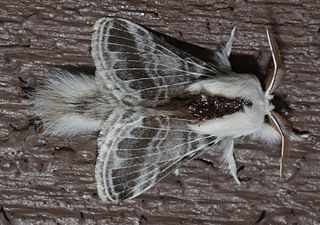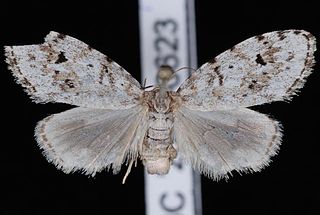
The red underwing is a moth of the family Erebidae. The species was first described by Carl Linnaeus in his 1767 12th edition of Systema Naturae.

Setina irrorella, the dew moth, is a moth of the family Erebidae. The species was first described by Carl Linnaeus in his 1758 10th edition of Systema Naturae. It is found in the Palearctic from Ireland, then through Europe and east to northern and central Asia to the Pacific Ocean. It is missing in the high north and parts of the Mediterranean region. It is found also in the limestone Alps up to 2,000 meters above sea level.

Aseptis characta is a moth of the family Noctuidae first described by Augustus Radcliffe Grote in 1880. It is widespread in western North America, where it is found in the western Great Plains, Great Basin, and Pacific regions from British Columbia, Alberta, and Saskatchewan to Colorado, Utah, northern Arizona and southern California. The species occurs in dry habitats like sagebrush steppe, juniper woodlands, and open forest from sea level to 2,500 meters.

Brunia antica is a moth of the family Erebidae described by Francis Walker in 1854. It is found from the Indian subregion, Sri Lanka to China, the Ryukyu Islands, the Chagos Archipelago, the Nicobar Islands and Sundaland.
Hellinsia cochise is a moth of the family Pterophoridae that is found in Arizona. The species was first described by William Barnes and Arthur Ward Lindsey in 1921.
Hellinsia varius is a moth of the family Pterophoridae that is found in the US states of California and Arizona. The species was first described by William Barnes and Arthur Ward Lindsey in 1921.
Hellinsia perditus is a moth of the family Pterophoridae first described by William Barnes and Arthur Ward Lindsey in 1921. It is found in the US states of California and Colorado.
Hypoprepia miniata, the scarlet-winged lichen moth or scarlet lichen moth, is a moth of the family Erebidae. The species was first described by William Kirby in 1837. It is found from British Columbia south through the western side of the Rocky Mountains to Arizona and Texas. It is also found throughout eastern North America.

Tolype velleda, the large tolype moth or velleda lappet moth, is a species of moth of the family Lasiocampidae. It was first described by Caspar Stoll in 1791. The species is found from Nova Scotia to central Florida, west to Texas and north to Ontario.
Zophodia multistriatella is a species of snout moth in the genus Zophodia. It was described by André Blanchard and Edward C. Knudson in 1982. It is found in the US states of Texas, Arizona and New Mexico.
Macrorrhinia dryadella is a species of snout moth in the genus Macrorrhinia. It was described by George Duryea Hulst in 1892 and is known from the US state of Florida.
Agaraea semivitrea is a moth of the family Erebidae. It was described by Walter Rothschild in 1909. It is found from northern South America, including Venezuela and Peru north to the US state of Texas.

Paectes arcigera is a moth in the family Euteliidae first described by Achille Guenée in 1852. It is restricted to the eastern Caribbean Islands, ranging from Puerto Rico to the Lesser Antilles.

Clemensia albata, the little white lichen moth, is a moth of the family Erebidae. It was described by Alpheus Spring Packard in 1864. It is found in eastern North America, west across boreal Canada to south-eastern British Columbia. The range extends along the Pacific Coast south to Monterey Bay in west-central California. The habitat consists of moist forests, including coastal rainforests, oak woodlands and mixed hardwood forests.
Apilocrocis pimalis, the Pima apilocrocis moth, is a moth in the family Crambidae. It was described by William Barnes and Foster Hendrickson Benjamin in 1926. It is found in North America, where it has been recorded from Arizona and Texas.
Drasteria pulchra is a moth of the family Erebidae first described by William Barnes and James Halliday McDunnough in 1918. It is found in North America, where it has been recorded from California.
Prolita dialis is a moth of the family Gelechiidae. It was described by Ronald W. Hodges in 1966. It is found in North America, where it has been recorded from Arizona, New Mexico, Texas and Mexico.
Prolita invariabilis is a moth of the family Gelechiidae. It was described by William D. Kearfott in 1908. It is found in the US states of Utah, Wyoming, Arizona, California, Colorado, Oregon and New Mexico.
Prolita rectistrigella is a moth of the family Gelechiidae. It was described by William Barnes and August Busck in 1920. It is found in North America, where it has been recorded from California, Arizona, New Mexico, Colorado, Utah, Wyoming, Montana, Washington and Alberta.
Scrobipalpula ochroschista is a moth in the family Gelechiidae. It was described by Edward Meyrick in 1929. It is found in North America, where it has been recorded from Texas.






